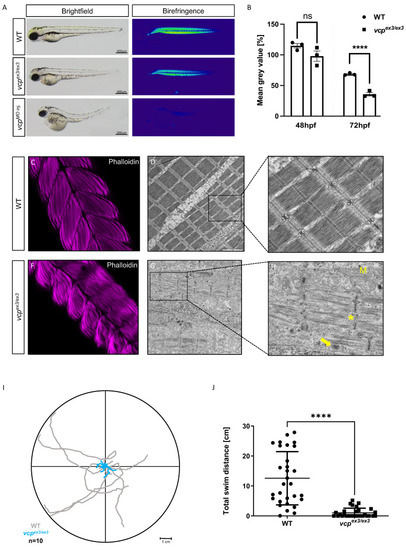Fig. 2
- ID
- ZDB-FIG-220628-26
- Publication
- Voisard et al., 2022 - CRISPR/Cas9-Mediated Constitutive Loss of VCP (Valosin-Containing Protein) Impairs Proteostasis and Leads to Defective Striated Muscle Structure and Function In Vivo
- Other Figures
- All Figure Page
- Back to All Figure Page
|
Genetic loss of vcp leads to skeletal muscle dysfunctions. (A) Lateral view of brightfield and birefringence images for WT, vcpex3/ex3, and VCP-MO-injected embryos at 72 hpf. (B) Densitometric analysis of the birefringence signal at 72 hpf reveals significantly reduced signal intensity in vcpex3/ex3 embryos, implying impaired skeletal muscle organization, whereas birefringence signal intensity is unaltered at 48 hpf (48 hpf: N = 3, n = 5/8, p = 0.6690; 72 hpf: N = 3, n = 8/15; p = 0.0001; two-tailed t-test). Error bars indicate s.d.; **** p < 0.0001; ns, not significant. (C,F) Confocal microscopic analysis of phalloidin-stained skeletal muscles of WT and vcpex3/ex3 embryos at 72 hpf. vcpex3/ex3 embryos show disrupted muscle fibers compared to the clutchmates. (D,E,G,H) Electron microscopic pictures of WT and vcpex3/ex3 skeletal muscle embryos at 72 hpf. vcpex3/ex3 embryos show damaged mitochondria (M) and increased electron-dense inclusion bodies (→) in addition to the disrupted muscle fibers (*). (I) Touch-evoked assay reveals reduction in responsiveness upon mechanical stimulus in vcpex3/ex3 embryos, as shown in the motion trace diagram. (J) Quantification of the total swim distance shows significantly reduced motility in vcpex3/ex3 compared to WT embryos (N = 3, n = 10, mean ± S.D; p < 0.0001; two-tailed t-test). Error bars indicate s.d.; **** p < 0.0001. ns: not significant. |
| Fish: | |
|---|---|
| Knockdown Reagent: | |
| Observed In: | |
| Stage Range: | Long-pec to Protruding-mouth |

